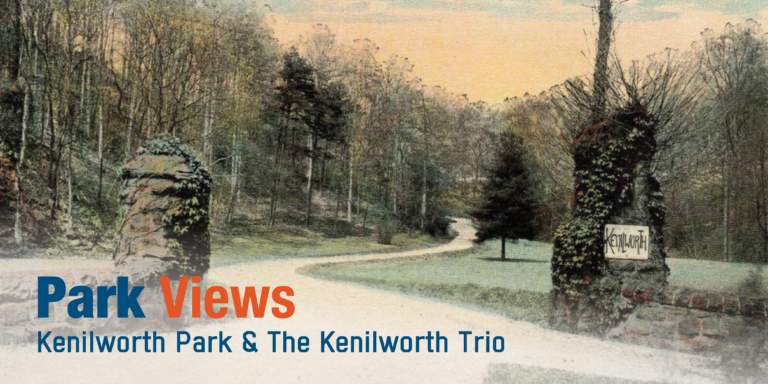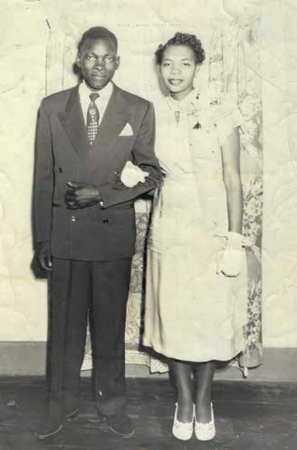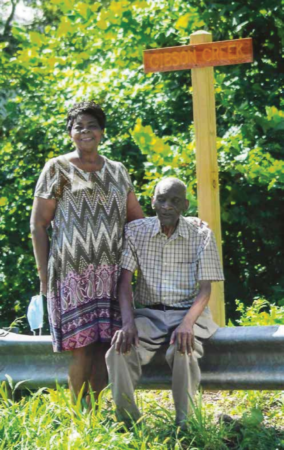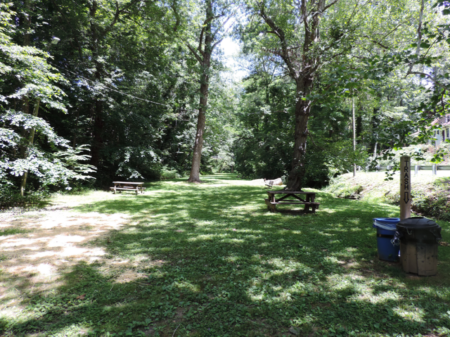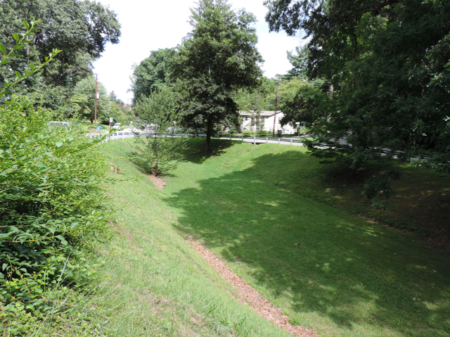This entry is part of Park Views, a weekly Asheville Parks & Recreation series that explores the history of the city’s public parks and community centers – and the mountain spirit that helped make them the unique spaces they are today. Read more from the series and follow APR on Facebook and Instagram for additional photos, upcoming events, and opportunities.
Park Views previously covered the histories of Harvest House Community Center and Leah Chiles Park. They’re part of a larger network of recreational spaces in the same neighborhood that includes Kenilworth, Seven Springs, Meadow, and Forest parks.
South Asheville
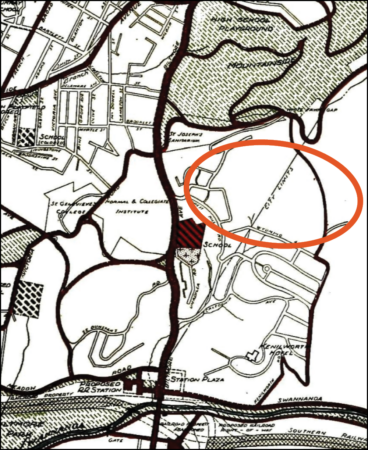 Kenilworth Park is located in the same area of the former community of South Asheville that was located between South Main Street (renamed Biltmore Avenue in 1914) and Beaucatcher Mountain, adjacent to land that developed as the Asheville suburb of Kenilworth. One of the wealthiest landowners in Buncombe County and second mayor of Asheville, James McConnell Smith purchased 254 acres of land in 1831 that included South Asheville.
Kenilworth Park is located in the same area of the former community of South Asheville that was located between South Main Street (renamed Biltmore Avenue in 1914) and Beaucatcher Mountain, adjacent to land that developed as the Asheville suburb of Kenilworth. One of the wealthiest landowners in Buncombe County and second mayor of Asheville, James McConnell Smith purchased 254 acres of land in 1831 that included South Asheville.
Following his death in 1856, his daughter Sarah Smith McDowell inherited the property that included South Asheville. She and her husband purchased the Smith-McDowell House following her brother’s death (who inherited the house from his father) just a year later and supported the development of a settlement for their 40 enslaved people and free Black families on their land.
When the Civil War ended, the McDowell family faced economic reversals and sold the house. After emancipation, Black families who lived in South Asheville purchased from or were given small lots by the McDowells where they built homes, schools, churches, and an entire community. More Black families moved to Buncombe County around the turn of the twentieth century in search of better job opportunities, many settling in the South Asheville community.
A portion of South Asheville was annexed to the Town of Kenilworth in 1927. Kenilworth itself was annexed to the City of Asheville in 1929 and another portion of South Asheville was annexed to the larger city in 1931. Over time, much of the former South Asheville community became associated with the Kenilworth neighborhood, though St. John ‘A’ Baptist Church and South Asheville Cemetery remain and are listed on the National Register of Historic Places.
A New Park
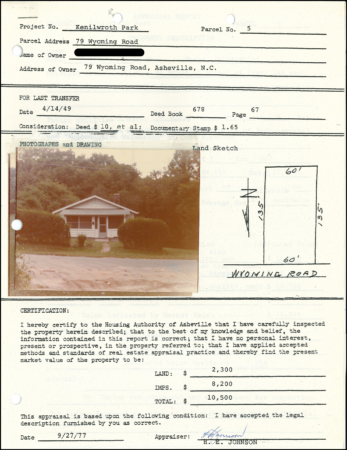 In 1930, local financial institutions failed, saddling Asheville with $41 million in debt – more than the debts of Raleigh, Durham, Greensboro, and Winston Salem combined. To prevent further liabilities, no new debts could be incurred unless they were approved by a majority of voters in a referendum. For this reason, the parks and recreation system remained largely stagnant during the following decades.
In 1930, local financial institutions failed, saddling Asheville with $41 million in debt – more than the debts of Raleigh, Durham, Greensboro, and Winston Salem combined. To prevent further liabilities, no new debts could be incurred unless they were approved by a majority of voters in a referendum. For this reason, the parks and recreation system remained largely stagnant during the following decades.
Federal programs aimed at reducing poverty through education and economic opportunities, health care access, and improving living conditions provided a financial pipeline for Asheville Parks & Recreation (APR) to address decades of deferred maintenance and build new parks during the 1970s and early 1980s. Under the Housing and Community Development Act of 1974, Asheville was designated an Entitlement City and Kenilworth was selected as an area to receive a new park.
During a community meeting in 1976, APR asked Kenilworth residents if there were any large tracts of land available 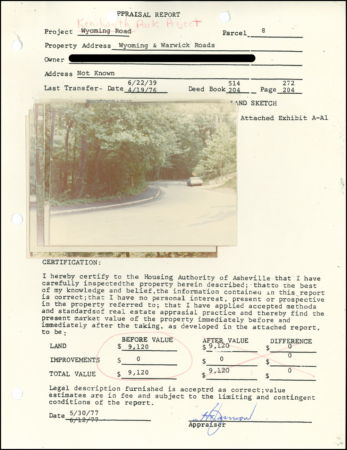 within the designated community development area and one of them mentioned the former Abograst Estate. While engineers deemed the site less than ideal, no other suitable locations emerged and the City of Asheville contracted with the Housing Authority of the City of Asheville (HACA) for property acquisitions and relocation services for affected residents.
within the designated community development area and one of them mentioned the former Abograst Estate. While engineers deemed the site less than ideal, no other suitable locations emerged and the City of Asheville contracted with the Housing Authority of the City of Asheville (HACA) for property acquisitions and relocation services for affected residents.
In total, five vacant residential lots and five single-family residences were purchased or acquired through condemnation for the new park. A hill was removed in Walton Street Park to further develop recreation features at that location with the dirt moved to Kenilworth Park to level its steep grade. In the process, Wyoming Road was widened and a culvert added to realign a creek that flowed through the area of the park earmarked for a ballfield.
Kenilworth Park
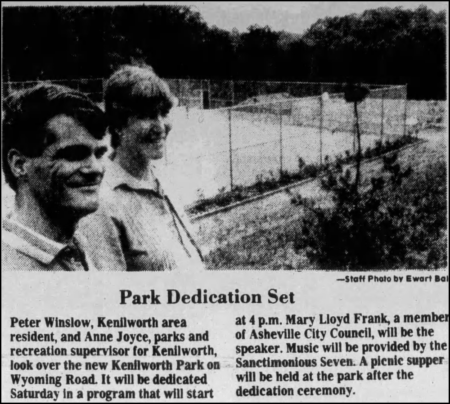 Kenilworth Park was dedicated on July 24, 1982 during a public ceremony followed by a softball game, parachute and frisbee demonstrations, community picnic, and entertainment by the Sanctimonious Seven. It contained tennis and basketball courts, ballfield, playground, and picnic and restroom facilities.
Kenilworth Park was dedicated on July 24, 1982 during a public ceremony followed by a softball game, parachute and frisbee demonstrations, community picnic, and entertainment by the Sanctimonious Seven. It contained tennis and basketball courts, ballfield, playground, and picnic and restroom facilities.
Upon opening, the park served as a summer playground site with supervised arts, crafts, and games for children, as well as hosting a softball league and tennis lessons for active older adults. Over the following years, a fitness trail opened within the park and well-cherished events including street dances, Kenilworth Day, Kenilworth Picnic in the Park, and others brought the space to life.
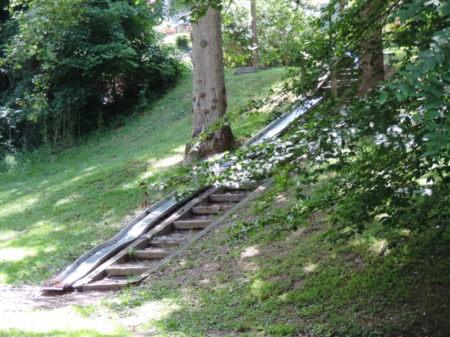 In the mid 1990s, APR began replacement of aging playgrounds throughout the city. Kenilworth residents held fundraisers to benefit renovations to the playspaces in Lakewood (now Leah Chiles) and Kenilworth parks including a neighborhood flea market in the park. The new playground opened in 2000.
In the mid 1990s, APR began replacement of aging playgrounds throughout the city. Kenilworth residents held fundraisers to benefit renovations to the playspaces in Lakewood (now Leah Chiles) and Kenilworth parks including a neighborhood flea market in the park. The new playground opened in 2000.
Many of the park’s original features are still present today, though the ballfield was converted to a soccer field in the 1990s and later to a multi-purpose field, and pickleball lines added to the tennis courts in 2015.
Gibson Creek
As part of RiverLink’s Name That Creek program, the waterway flowing through Kenilworth Park was designated Gibson Creek in honor of South Asheville’s Gibson family in 2018. John Henry and Cora Lee Gibson moved to the area in 1922 and John Henry worked as a caretaker for Dr. William Dunn who provided a house for the family on his Beaucatcher Mountain property.
In 1950, John Henry and Cora Lee’s son George married Louise Mauldin, a fellow Asheville native. They purchased land near the south slope of Beaucatcher Mountain and frequently opened their home to neighborhood kids who were friends with their children. Gibson Creek flows from their property through Kenilworth, Seven Springs, and Meadow parks to the Swannanoa River.
With an estimated two thousand graves, the South Asheville Cemetery is considered the oldest public Black cemetery in western North Carolina. Next to St. John ‘A’ Baptist Church, it was founded in the early 1800s as a burial ground for people who had been enslaved by the Smith and McDowell families, one of the few cemeteries for Black people in the region.
The last person interred in the cemetery was Robert C. Watkins in 1943. The cemetery was largely neglected from that time until George began to clear the overgrowth in the 1980s. As word spread, community members and volunteers helped in his effort and the South Asheville Cemetery Association was formed to keep the historic resting place in the public eye.
The Kenilworth Trio
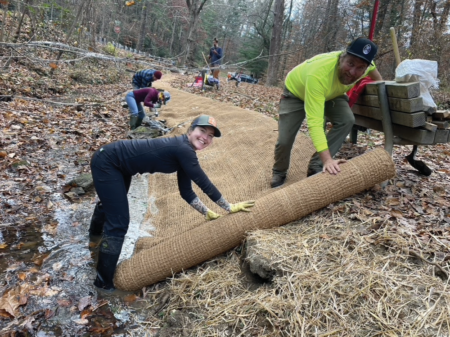 When Kenilworth was established as an independent town in 1914, developers envisioned multiple parks for the community’s enjoyment. Kenilworth Development Company donated a trio of properties off Caledonia Road to the town in 1923.
When Kenilworth was established as an independent town in 1914, developers envisioned multiple parks for the community’s enjoyment. Kenilworth Development Company donated a trio of properties off Caledonia Road to the town in 1923.
When Kenilworth was annexed to the City of Asheville in 1929, they became part of the municipal parks system and can be enjoyed today.
The largest, Seven Springs Park (called Spring Park on the deed) features a steep trail notched into the side of a hill that curves around Gibson Creek. Formerly a quarry, it originally featured a rock garden, stone staircase, and pond area. Though it contained a small playground at one point, it is primarily used today by those looking for a short wooded hike within city limits or as a pedestrian trail for joggers and walkers avoiding vehicular traffic.
Across from Seven Springs’ western trailhead, Meadow Park includes natural spaces to relax, read a book, or enjoy a picnic with friends. The original entrance to Kenilworth was Caledonia Road off of Biltmore Avenue and Meadow Park was one of the first landmarks passed as people arrived in the town. In 1928, it had four swings, four seesaws, horseshoe pits, and a sandbox.
Steps away from Seven Springs’ eastern end, Forest Park features a rolling lawn ideal for football, frisbee, and other games. Sometimes called Caledonia Bowl, it exemplifies the natural beauty common to parks of its era.
Do you have photos or stories to share about Kenilworth Park or the Kenilworth Trio? Please send them to cbubenik@ashevillenc.gov so APR can be inspired by the past as we plan our future.
Photo and Image Credits
- Postcard published around 1915 by S.H. Kress & Co. titled, “Swannanoa Entrance to Kenilworth Park, Asheville, N.C.” Kenilworth Park was the name of the residential development rather than today’s park with the same name. Courtesy of Buncombe County Special Collections, Pack Memorial Public Library, Asheville, North Carolina.
- The boundaries of South Asheville were roughly within the orange oval and include part of Wyoming Road with Kenilworth Road as the boundary between the white homes of Kenilworth and the Black homes of South Asheville that were scattered along unpaved roads and footpaths. Structures were built using any available materials and usually had no electricity or plumbing with water for washing and drinking coming from springs and creeks. John Nolen and Philip W. Foster, City Planning Report: Asheville, North Carolina, Cambridge, MA: Harvard Square, 1922.
- HACA hired H.E. Johnson to appraise properties for acquisition to build Kenilworth Park. This residence’s address of 79 Wyoming Road is now the park’s address.
- Half of the parcels were vacant and undeveloped including this one. Wyoming Road was widened and straightened to create the park, so this curve at Warwick Road no longer exists.
- Typical of most neighborhood parks developed in Asheville during the 1970s and 1980s, the park included tennis and basketball courts, ballfield, playground, restrooms, picnic areas, and some parking.
- A popular feature of Kenilworth Park was a slide built into the hill cascading from Warwick Road.
- George and Louise Gibson were married for 59 years, until her passing. Both graduates of Stephens-Lee High School, their two youngest children were some of the first students to attend Asheville’s newly-integrated schools in the 1960s.
- George Gibson Sr. and daughter Olivia Gibson Metz pose with a sign installed at the corner of Norfolk Street and Wyoming Road.
- Through the City of Asheville’s Neighborhood Matching Grant program, Kenilworth Residents’ Association are repairing the riparian buffer of Gibson Creek by planting native woody plants and restoring 200 ft of heavily eroded creek bank in Meadow Park in collaboration with RiverLink. Courtesy of Kenilworth Residents’ Association.
- Meadow Park features a mix of hardwood trees, shrubs, and native and non-native plants.
- Also known as Caledonia Bowl, Forest Park is designed for passive recreation and to reduce the impacts of flooding.
